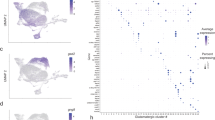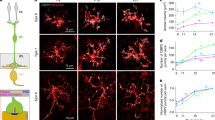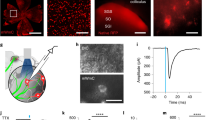Abstract
Activity is thought to guide the patterning of synaptic connections in the developing nervous system. Specifically, differences in the activity of converging inputs are thought to cause the elimination of synapses from less active inputs and increase connectivity with more active inputs1,2. Here we present findings that challenge the generality of this notion and offer a new view of the role of activity in synapse development. To imbalance neurotransmission from different sets of inputs in vivo, we generated transgenic mice in which ON but not OFF types of bipolar cells in the retina express tetanus toxin (TeNT). During development, retinal ganglion cells (RGCs) select between ON and OFF bipolar cell inputs (ON or OFF RGCs) or establish a similar number of synapses with both on separate dendritic arborizations (ON-OFF RGCs). In TeNT retinas, ON RGCs correctly selected the silenced ON bipolar cell inputs over the transmitting OFF bipolar cells, but were connected with them through fewer synapses at maturity. Time-lapse imaging revealed that this was caused by a reduced rate of synapse formation rather than an increase in synapse elimination. Similarly, TeNT-expressing ON bipolar cell axons generated fewer presynaptic active zones. The remaining active zones often recruited multiple, instead of single, synaptic ribbons. ON-OFF RGCs in TeNT mice maintained convergence of ON and OFF bipolar cells inputs and had fewer synapses on their ON arbor without changes to OFF arbor synapses. Our results reveal an unexpected and remarkably selective role for activity in circuit development in vivo, regulating synapse formation but not elimination, affecting synapse number but not dendritic or axonal patterning, and mediating independently the refinement of connections from parallel (ON and OFF) processing streams even where they converge onto the same postsynaptic cell.
This is a preview of subscription content, access via your institution
Access options
Subscribe to this journal
Receive 51 print issues and online access
$199.00 per year
only $3.90 per issue
Buy this article
- Purchase on Springer Link
- Instant access to full article PDF
Prices may be subject to local taxes which are calculated during checkout




Similar content being viewed by others
References
Wong, R. O. L. & Lichtman, J. W. in Fundamental Neuroscience 2nd edn (eds Squire, L. R. et al.) Ch. 20 533–554 (Academic Press, 2002)
Miller, K. D. Synaptic economics: competition and cooperation in synaptic plasticity. Neuron 17, 371–374 (1996)
Masland, R. H. The fundamental plan of the retina. Nature Neurosci. 4, 877–886 (2001)
Wassle, H. Parallel processing in the mammalian retina. Nature Rev. Neurosci. 5, 747–757 (2004)
Ueda, Y., Iwakabe, H., Masu, M., Suzuki, M. & Nakanishi, S. The mGluR6 5′ upstream transgene sequence directs a cell-specific and developmentally regulated expression in retinal rod and ON-type cone bipolar cells. J. Neurosci. 17, 3014–3023 (1997)
Schiavo, G. et al. Tetanus and botulinum-B neurotoxins block neurotransmitter release by proteolytic cleavage of synaptobrevin. Nature 359, 832–835 (1992)
Harms, K. J. & Craig, A. M. Synapse composition and organization following chronic activity blockade in cultured hippocampal neurons. J. Comp. Neurol. 490, 72–84 (2005)
Chichilnisky, E. J. A simple white noise analysis of neuronal light responses. Network 12, 199–213 (2001)
Maslim, J., Webster, M. & Stone, J. Stages in the structural differentiation of retinal ganglion cells. J. Comp. Neurol. 254, 382–402 (1986)
Coombs, J. L., Van Der List, D. & Chalupa, L. M. Morphological properties of mouse retinal ganglion cells during postnatal development. J. Comp. Neurol. 503, 803–814 (2007)
Wang, G. Y., Liets, L. C. & Chalupa, L. M. Unique functional properties of On and Off pathways in the developing mammalian retina. J. Neurosci. 21, 4310–4317 (2001)
Nelson, R., Famiglietti, E. V. & Kolb, H. Intracellular staining reveals different levels of stratification for on- and off-center ganglion cells in cat retina. J. Neurophysiol. 41, 472–483 (1978)
Morgan, J. L., Schubert, T. & Wong, R. O. L. Developmental patterning of glutamatergic synapses onto retinal ganglion cells. Neural Develop. 3, 8 (2008)
Morgan, J. L., Dhingra, A., Vardi, N. & Wong, R. O. L. Axons and dendrites originate from neuroepithelial-like processes of retinal bipolar cells. Nature Neurosci. 9, 85–92 (2006)
Ghosh, K. K., Bujan, S., Haverkamp, S., Feigenspan, A. & Wassle, H. Types of bipolar cells in the mouse retina. J. Comp. Neurol. 469, 70–82 (2004)
Sterling, P. & Matthews, G. Structure and function of ribbon synapses. Trends Neurosci. 28, 20–29 (2005)
Regus-Leidig, H., Tom Dieck, S., Specht, D., Meyer, L. & Brandstatter, J. H. Early steps in the assembly of photoreceptor ribbon synapses in the mouse retina: the involvement of precursor spheres. J. Comp. Neurol. 512, 814–824 (2009)
Zhai, R. G. et al. Assembling the presynaptic active zone: a characterization of an active one precursor vesicle. Neuron 29, 131–143 (2001)
Johnson, J. et al. Vesicular neurotransmitter transporter expression in developing postnatal rodent retina: GABA and glycine precede glutamate. J. Neurosci. 23, 518–529 (2003)
Okabe, S., Miwa, A. & Okado, H. Spine formation and correlated assembly of presynaptic and postsynaptic molecules. J. Neurosci. 21, 6105–6114 (2001)
Niell, C. M., Meyer, M. P. & Smith, S. J. In vivo imaging of synapse formation on a growing dendritic arbor. Nature Neurosci. 7, 254–260 (2004)
Buffelli, M. et al. Genetic evidence that relative synaptic efficacy biases the outcome of synaptic competition. Nature 424, 430–434 (2003)
Kasthuri, N. & Lichtman, J. W. The role of neuronal identity in synaptic competition. Nature 424, 426–430 (2003)
Hua, J. Y., Smear, M. C., Baier, H. & Smith, S. J. Regulation of axon growth in vivo by activity-based competition. Nature 434, 1022–1026 (2005)
Sanes, J. R. & Yamagata, M. Formation of lamina-specific synaptic connections. Curr. Opin. Neurobiol. 9, 79–87 (1999)
Shaner, N. C. et al. Improved monomeric red, orange and yellow fluorescent proteins derived from Discosoma sp. red fluorescent protein. Nature Biotechnol. 22, 1567–1572 (2004)
Marquardt, T. et al. Pax6 is required for the multipotent state of retinal progenitor cells. Cell 105, 43–55 (2001)
Kerschensteiner, D. et al. Genetic control of circuit function: Vsx1 and Irx5 transcription factors regulate contrast adaptation in the mouse retina. J. Neurosci. 28, 2342–2352 (2008)
Acknowledgements
We are grateful to J. Sanes and R. W. Burgess for TeNT–CFP, S. Naganishi for the mGluR6 promoter fragment, A. M. Craig for PSD95–CFP and R. Y. Tsien for tdTomato. We thank F. Soto, L. Godinho, A. Lewis, F. Dunn and T. Misgeld for comments on the manuscript. This work was supported by the National Institutes of Health (R.O.L.W., EY10699, J.L.M. T32 EY07031), the McDonnell Foundation at Washington University (R.O.L.W.), National Eye Institute core grant (E.D.P., EY01730) and the Deutsche Forschungsgemeinschaft (D.K., KE 1466/1-1).
Author Contributions D.K. and R.O.L.W. conceived the experiments. D.K. and R.M.L. generated transgenic constructs. D.K. performed and analysed patch-clamp and multi-electrode array recordings, and imaging experiments on fixed tissue. D.K. and J.L.M. performed and analysed live imaging experiments. D.K., E.D.P. and R.O.L.W. carried out the ultrastructural analysis. D.K. and R.O.L.W. wrote the paper.
Author information
Authors and Affiliations
Corresponding authors
Supplementary information
Supplementary Information
This file contains a Supplementary Discussion, Supplementary Figures S1-S9 with Legends and Supplementary References. (PDF 1374 kb)
Supplementary Movie 1
This movie focuses through the representative RGC dendrite shown in Figure 2c expressing tdTomato (blue) and PSD95-CFP (red) in a P21 mGluR6-YFP/TeNT mouse (bipolar cell terminals in green). (MOV 2565 kb)
Rights and permissions
About this article
Cite this article
Kerschensteiner, D., Morgan, J., Parker, E. et al. Neurotransmission selectively regulates synapse formation in parallel circuits in vivo. Nature 460, 1016–1020 (2009). https://doi.org/10.1038/nature08236
Received:
Accepted:
Issue Date:
DOI: https://doi.org/10.1038/nature08236
This article is cited by
-
Dynamic assembly of ribbon synapses and circuit maintenance in a vertebrate sensory system
Nature Communications (2019)
-
Stimulation of functional neuronal regeneration from Müller glia in adult mice
Nature (2017)
-
Homeostatic plasticity shapes the visual system’s first synapse
Nature Communications (2017)
-
Stereotyped initiation of retinal waves by bipolar cells via presynaptic NMDA autoreceptors
Nature Communications (2016)
-
Learning-guided automatic three dimensional synapse quantification for drosophila neurons
BMC Bioinformatics (2015)
Comments
By submitting a comment you agree to abide by our Terms and Community Guidelines. If you find something abusive or that does not comply with our terms or guidelines please flag it as inappropriate.



